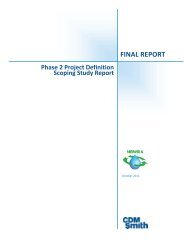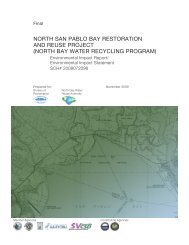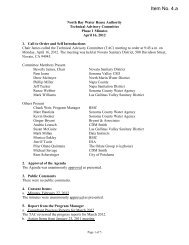Phase 3 Feasibility Report (Table of Contents & Executive Summary)
Phase 3 Feasibility Report (Table of Contents & Executive Summary)
Phase 3 Feasibility Report (Table of Contents & Executive Summary)
Create successful ePaper yourself
Turn your PDF publications into a flip-book with our unique Google optimized e-Paper software.
Draft <strong>Phase</strong> 3 Engineering and Economic/Financial Analysis <strong>Report</strong><br />
<strong>Executive</strong> <strong>Summary</strong><br />
locations <strong>of</strong> the Project area. Areawide, the “local” recipients <strong>of</strong> recycled water<br />
would include the Peacock Gap golf course, urban users in Novato, the existing<br />
SVCSD reuse area, the Sonoma Valley Recycled Water Project, the Napa MST area,<br />
and the Carneros East area. The “regional” recipients would include the<br />
agricultural users in Sears Point, the Southern Sonoma Valley, and the Central<br />
Sonoma Valley areas, as well as the Napa Salt Marsh restoration area.<br />
Within the alternatives described above, the Authority members have collectively<br />
prioritized the projects within their individual service areas to identify a phased<br />
implementation plan under any <strong>of</strong> the alternatives being considered. The first phase<br />
(<strong>Phase</strong> 1) <strong>of</strong> alternative implementation includes projects that each member agency<br />
has defined to a level <strong>of</strong> detail that allows both for project-level environmental review<br />
in other sections <strong>of</strong> the feasibility study, and short-term readiness for design, funding,<br />
and construction. Each treatment plant puts first priority on the delivery <strong>of</strong> recycled<br />
water to its local projects. Local projects include the Novato urban users, the Sonoma<br />
Valley Recycled Water Project, the Napa MST area, and the Napa Salt Marsh<br />
restoration area.<br />
A fourth alternative, the “No Action Alternative”, assumes that there is no joint<br />
Project. It essentially represents the “current status” in which the potential need to<br />
develop additional potable water supplies continues to be a regional challenge, and<br />
additional treatment capacity and water recycling might occur strictly from the<br />
implementation <strong>of</strong> local plans for expansion, as funding is available.<br />
Of the action alternatives, Alternative 1 has the lowest associated costs and provides<br />
the least recycled water supply; Alternative 3 has the highest costs and provides the<br />
greatest amount <strong>of</strong> recycled water. The differences in cost among the alternatives<br />
stems from the successively greater installation <strong>of</strong> pipelines, storage, treatment, and<br />
pumping facilities associated with each in turn.<br />
The recycling benefits and costs <strong>of</strong> the alternatives are summarized below:<br />
<strong>Summary</strong> <strong>of</strong> Recycling Capacity and Associated Costs <strong>of</strong> Alternatives <strong>of</strong> the<br />
North San Pablo Bay Restoration and Reuse Project<br />
Action Alternative New Recycled<br />
Water Demand<br />
(Beneficial<br />
Reuse)<br />
Developed by<br />
Total Recycled<br />
Water Demand<br />
in the Project<br />
Area (w/Project)<br />
Discharge<br />
to Bay<br />
Estimated<br />
Capital<br />
Costs<br />
(millions)<br />
Estimated<br />
Annual<br />
Operations &<br />
Maintenance<br />
Costs (millions)<br />
the Alternative (1)<br />
No Action Alternative 0 AF 4,944 AF 22,711 AF $270 M --<br />
Alternative 1 – Basic 6,455 AF 11,329 AF 16,256 AF $210 M $1.8 M<br />
Regional System<br />
Alternative 2 –<br />
11,215 AF 16,159 AF 11,496 AF $378 M $2.8 M<br />
Regional System<br />
Alternative 3 –<br />
12,725 AF 17,669 AF 9,986 AF $414 M $3.1 M<br />
Interconnected<br />
Regional System<br />
(1)<br />
The new recycled water demand developed by the alternatives represents total beneficial reuse to customers.<br />
Additional recycled water is available from SVCSD and Napa SD for the Napa Salt Marsh which is not included in<br />
these totals, as the amount <strong>of</strong> water needed for the Napa Salt Marsh is unknown at this time. Supplying recycled<br />
water to the Napa Salt Marsh would further reduce discharges to San Pablo Bay.<br />
A<br />
ES-7








